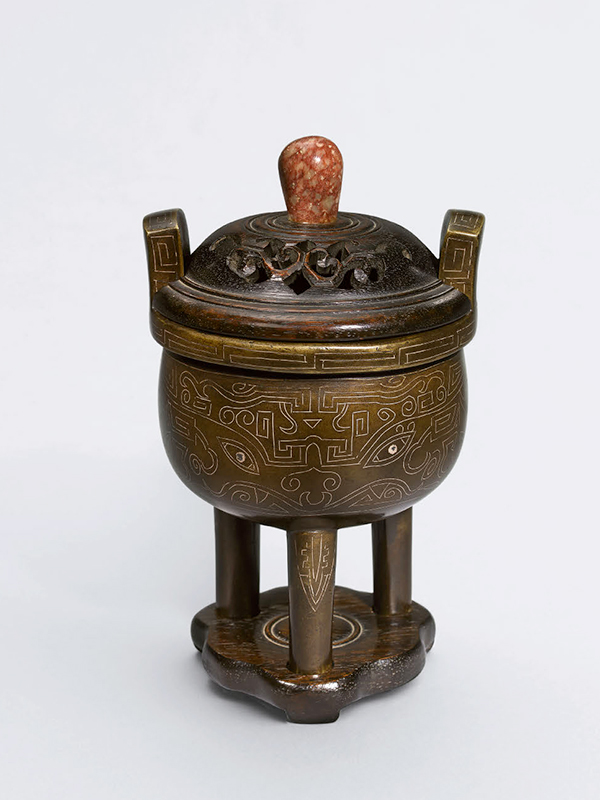Silver inlaid bronze censer of ding form
Late Ming to Qing dynasty, 17th - 18th century
A bronze incense burner in the form of an archaic ding vessel, the rounded bowlshaped body supported on three straight legs. The flat, Iipped rim is applied with two U-shaped handles. The exterior is inlaid in fine silver wire with a design of archaistic taotie masks and a wide key fret pattern to the rim. A single pointed leaf design is applied to each leg. The vessel has an even bronze patina. The underside of the body is inlaid with a two-character signature, reading Shi Sou. The censer has a hardwood cover and stand: the cover is carved in openwork and has an agate final, whilst the stand is of triangular shape and incised with a Yin-yang pattern in the middle. The censer is contained within a Japanese wooden box.
The form of this incense burner clearly imitates bronze vessels of the late Shang (16th century – c. 1046 BC) and early Western Zhou (c. 1046 – 771BC) dynasties. These vessels, known as ding, were used for cooking and ritual offerings. According to the Ge Gu Yao Lun (‘Essential Criteria of Antiquities’), which was compiled by Cao Zhao in 1388, archaic bronze vessels were never used as incense burners. The compactness and portability of ancient bronze tripods of this type enabled them to be used as censers in later periods, particularly in a domestic setting or in the scholars’ studio.1 The signature Shi Sou might refer to an individual artist or is possibly the name of a very large workshop.2 In the present vessel, the delicate inlay of the silver is of fine quality and contrasts well with the patina of the bronze. A very similar bronze censer of ding form and with Shi Sou mark on the base, slightly larger in size and with comparable taotie decoration in silver inlay, is dated to the 17th to 18th century and is in the collection of the British Museum.3
Provenance: private collection, Japan
- Mowry, R. Later Chinese Bronzes: The Saint Louis Art Museum and Robert E. Kresko Collections, Saint Louis Art Museum, 2008, p. 57
- Kerr, R. Later Chinese Bronzes, Bamboo Publishing Ltd., London, 1990, p. 65
- The British Museum online collection archive, registration number: 1985,1010.1

